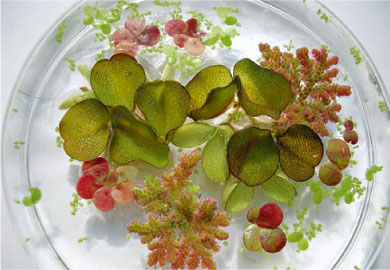MICHAEL RAUHE // PHOTOS: KARLSRHEINZ KNOCH; ANDREA FABRY // TRANSLATION: MAIKE SCHRÖDER

Nanoscientists from Karlsruhe, Bonn, and Rostock have discovered the Salvinia effect. Under water, salvinia, an otherwise unimpressive tropical floating fern, can retain air in its hairs and remain completely dry. The technical potential of this effect is great according to Professor Thomas Schimmel from Karlsruhe Institute of Technology (KIT). By means of the Salvinia effect, energy consumption of ships in particular may be reduced drastically.

If the floating fern is pressed under water by wind or a duck, it rapidly builds up an envelope of air that enables it to survive. But how does the plant manage to prevent the air from escaping? The leaf does not only have to contain a storage area for the air, it also must prevent air bubbles from leaving the hairs while the fern continues to breathe. Salvinia molesta has the stunning capacity to retain the thin air layer under water for 14 days at least.
Schimmel and his colleagues have now discovered the trick found by nature. While the surface of the individual hairs is water-repellent, their tips are able to retain the water film. If the water detaches from the surface tips of the hairs when a bubble forms, the water film remains adherent to the boundary layer where the air layer ends and the water film starts.
Schimmel's team demonstrated the Salvinia effect at the laboratory. The water-retaining hair tips were simply covered by a water-repellent nanocoating. Suddenly, the plant was no longer able to retain the air. As soon as the artificial surface was covered by adhesive nanodots at the hair tips, the plant regained its capacity to retain an air layer.
 |
 |